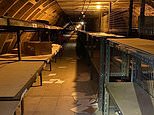
During the height of the Blitz in London the government commissioned the building of ten deep-level shelters to keep Londoners safe from the constant threat of bombs.
But by the time shelters, built to accommodate up to 8,000 people, were complete the Blitz had ended and the threat was perceived to be over.
Work began on the tunnels in 1940 as part of a dash to prepare the capital against the imminent Nazi attack and possible invasion that some feared Hitler would launch. Triple decker beds were installed throughout in case thousands of people had to be housed at short notice.
They were completed within eight months, but at tragic cost because 11 workers were killed in the effort.
The shelters ran along the Northern Line at Belsize Park, Camden Town, Chancery Lane, Goodge Street, Stockwell, Clapham North, Clapham Common and Clapham South.
They were not used until 1944, when the worst of the Blitz was over and the tide was turning back in the Allies’ favour after the Soviet Union and the US joined Britain against Germany.
The eight buildings (two had been abandoned during construction) were used for military storage and staff accommodation. By July 1944, however, the Germans launched a further bombing campaign in retaliation following the D-Day landings and the shelters were opened to the public for the first time.
The Nazis had started firing V1 and V2 rockets across the English Channel, with between 100 and 150 fired each day, killing 2,700 people and injuring more than 6,000 by the end of the war.
The shelters ran along the Northern Line at Belsize Park, Camden Town, Chancery Lane, Goodge Street, Stockwell, Clapham North, Clapham Common and Clapham South
Lights would go out at 10.30pm on the dot, and come back on at 7am, with visitors given 30 minutes to get out. People whose homes had been destroyed would be allowed to store their possessions below ground while there were two medical rooms with nurses on hand to treat any injuries. Pictured, Belsize Park shelter in use
Tickets were issued to reduce queuing and allow Londoners access to a bunk bed for the night under a fair system, with each shelter also built with canteens available – a step up from the absence of any resources when Britons used the London Underground for shelter during the Blitz. Pictured, Belsize Park shelter while it was in use
The tunnels divide into 16 separate shelters and were meant to be used by those who did not have their own in their back garden to protect themselves against Luftwaffe raids.
Lights would go out at 10.30pm on the dot, and come back on at 7am, with visitors given 30 minutes to get out.
People whose homes had been destroyed would be allowed to store their possessions below ground while there were two medical rooms with nurses on hand to treat any injuries.
Although hygiene would not have been highest on the list of priorities, there were eight blocks of toilets and washing facilities that would have been cleaned out once a week.
Tickets were issued to reduce queuing and allow Londoners access to a bunk bed for the night under a fair system, with each shelter also built with canteens available – a step up from the absence of any resources when Britons used the London Underground for shelter during the Blitz.
They were pressed into service again in 1948 to house an influx of immigrants from the Caribbean, and again three years later when they became a temporary base for visitors to the Festival of Britain.
Belsize Park
At Belsize Park only one tunnel was ever used as a shelter. Bunks were fitted along the outer wall of each section – a single at the top, a double in the middle and a single at the bottom.
Along the inner wall bunks were fitted across the passage and formed bays. There were 4,380 bunks in total and each was allocated to a named person, meaning if they didn’t turn up the bunk remained unused. The southern tunnel was reserved for other, unrecorded government uses.
The entrance to Belsize Park Deep Shelter still has the Abbot Datastore logo from when it was used for storage by the company through the 1990s – the last time it was in use
Camden Town
There are two entrances to the Camden Town shelter, one in Buck Street and the other in Underhill Street, behind the Marks and Spencer car park.
Just inside the main entrance there are a number of small rooms now used as an office by the archive company who rent the shelter.
Then comes the top of the lift shaft with a twin spiral staircases around it, one to each of the lower levels. There is a map on the wall titled ‘Camden Town deep shelter’ showing the layout.
The entrance to the Camden Town deep shelter is now covered in graffiti. Just inside the main entrance there are a number of small rooms now used as an office by the archive company who rent the shelter
Chancery Lane
The shelter at Chancery Lane was converted to a telephone exchange after the war. It lacks a drum-shaped surface building, but signs of its existence include a wood-lined ventilation shaft on Leather Lane.
The Chancery Lane shelter does not have the same rounded facade as the others, but a clue to its existence includes this wooden ventilation shaft
Goodge Street
General Eisenhower used the subterranean site at Goodge Street as his headquarters during the build up to D-Day. It’s now used for document storage.
Goodge Street shelter continued is use as an army transit centre until it was damaged by a fire on May 21 1956.
Stockwell
The Stockwell deep-level shelter is located below Stockwell station and features two parallel tunnels, measuring 16ft in diameter and split horizontally with upper and lower levels. The shelters were accessed by two pillbox-shaped entrance shafts.
One, on Stockwell’s traffic island, is now a colourful World War II memorial, while the other is on Studley Road.
The entrance to the Stockwell deep level shelter is covered in a dramatic and brightly-coloured World War II mural
Clapham North
Clapham North deep-level shelter was leased to urban farm ‘Growing Underground’ for trials of their hydroponic growing of salads and herbs in 2015. It was not considered cost-effective to restore the lift so the enterprise moved to nearby Clapham Common deep-level shelter a few years later.
Clapham Common
This is now where the ‘Growing Underground’ urban farm has been set up.
Clapham South
The mile-long length of tunnels at Clapham South are the deepest of the deep-level shelters and sit beneath the Northern line.
The mile-long length of tunnels at Clapham South are the deepest of the deep-level shelters and sit beneath the Northern line
Source link
CHECK OUT: Top Travel Destinations
READ MORE: Travel News



